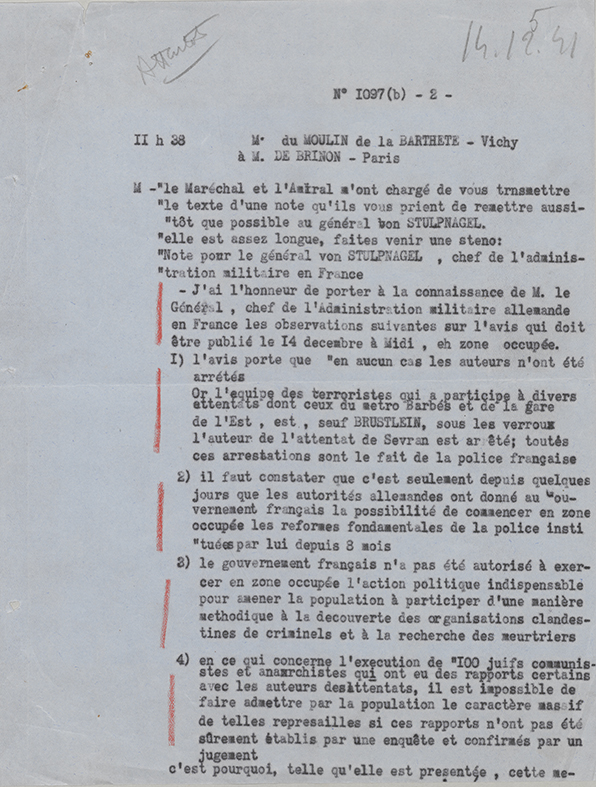The secret services of Vichy
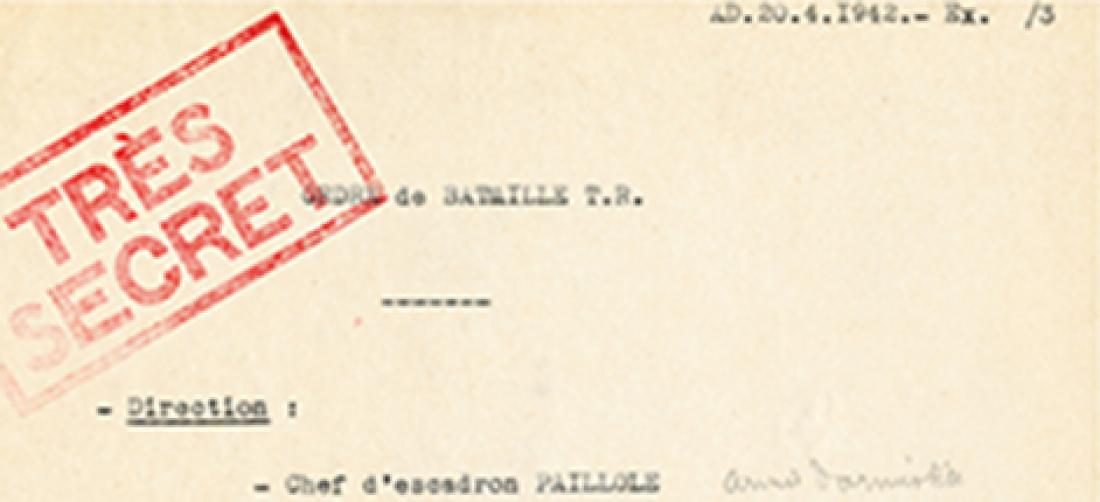
A recent film, The Imitation Game, recalled the essential role played by the cracking of the Enigma code in the Allied victory. But who knew that the French secret services had recruited Hans Thilo Schmidt as early as 1931? This German spy was the source of the first information about the machine for encrypting secret messages. Without this intelligence, it would probably not have been possible to reconstitute the machine or to figure out how it worked.
The German spy Hans Thilo Schmidt continued to deliver secrets to his French handlers until 1943. It was an organisation reporting to the French state led by Marshal Pétain that continued to deal with a spy whose actions certainly contributed to the fall of the Third Reich. This simple observation gives an idea of the complexity of understanding Vichy's special services, whose anti-German activities were emphasised after the war in a number of books supported by a very active association of former members. Their statements seem to lend credit to the idea of double-dealing on the part of Vichy. And yet the rediscovery of these services' archives paints a more nuanced picture: their actions were not directed solely against Germany and Italy, but also against Gaullists, communists and anyone who could get in the way of Marshal Pétain's policies. Through them, the army played a role in imposing surveillance on the French under the Occupation.
The secret services: civilian or military prerogatives?
To understand this role, we must look back at the history of the military secret services. They include the services gathering military intelligence (SR) and combating espionage, but not the exploitation of the intelligence, which was carried out at each level of the staff organisations by so-called ”2nd bureaux”. In France, the scandal of the Dreyfus affair (1894) led to restrictions on the army's prerogatives in terms of counter-espionage: from 1899, this function was entrusted to the Ministry of the Interior in peace-time. During the First World War, military counter-espionage was reconstituted in the form of an intelligence centralisation section (SCR) reporting to the War Ministry. In 1919, the mission of counter-espionage returned to the Ministry of the Interior, but the military retained a reduced SCR authorised solely to gather information but not to pursue suspects. Thousands of files were put together between the wars - personal files on foreigners, French suspects and voluntary providers of information, but also on political organisations and companies.
When the Second World War broke out, the military regained their prerogatives in repressing espionage. All the military special services - the SR Guerre (war intelligence service) led by Colonel Rivet with an aeronautical division, the SR Marine (navy intelligence service) and the SCR - were brought together in the staff offices named the 5th bureau. Intelligence centralisation offices (BCRs) were established in each military district and each major unit, led by a military security officer with authority over the civilian forces of order; he could ask the general commanding the district to refer suspects to military tribunals (see slideshow).
When the French forces collapsed in June 1940, the special services fell back, with all their archives, to the south of France. Acting on the basis that the 5th bureaux would soon be dissolved, Colonel Louis Rivet, chief of the 5th bureau of the War staff, gathered his officers together at the Bon-Encontre seminary near Agen and planned to organise camouflaged intelligence services. The armistice authorised the 2nd bureaux that exploited intelligence, but not the search for intelligence against the Axis and its allies.
The birth of the Vichy secret services
This is how, in July 1940, clandestine networks came to be born that were officially attached to the 2nd bureaux of each armed force. The camouflaged SR Guerre took the name of Kléber under the leadership of Lieutenant-Colonel Perruche. It had command posts in Vichy and Royat under the cover of an ”Office du Retour à la Terre” (”office of the return to the land”). The aeronautical section of the SR Guerre became an independent SR Air led by Colonel Ronin, with its command post in Cusset (Allier). These services maintained links with the Intelligence Service in London. The SR Marine, directed by Captain Samson, was attached to the 2nd staff bureau of the Navy and acquired its own counter-espionage section, which became Sécurité navale (naval security) in 1942.
Meanwhile, fears that the army would be dissolved proved unfounded. The events of Mers el-Kébir and then Dakar meant that the Vichy authority maintained an army, whose numbers amounted to 550,000 men, including 21,000 officers, at the beginning of 1942, not to mention the Chantiers de la jeunesse youth organisation. The military counter-espionage services were thus maintained, perpetuating the wartime situation. Only the names changed: the intelligence centralisation section (SCR) became the Service des menées antinationales (MA, anti-national activities service) and the BCRs became the Bureaux des menées antinationales (BMA). The organisation was identical. Reporting to the 2nd bureau of the Army, based in Royat and led by Lieutenant-Colonel Guy d'Alès, these offices had the goal of ”protecting the secrecy of national defence and protecting the army against anti-national activities”. This meant fighting espionage, sabotage, propaganda of all kinds and communist activity within the armed forces and the Chantiers de la jeunesse. The Menées Antinationales (MA) service was accepted by the German armistice committees on the condition that any activities hostile to the interests of the German or Italian armies or their allies were prohibited. The ”offensive” counter-espionage section - pursuing German and Italian spies and collecting intelligence against the Axis powers - was thus officially dissolved.
Very discreet secret services
It survived by concealing itself under the cover of an organisation reporting to the Ministry of Agriculture, the society of Travaux ruraux (TR, rural works). Organised into about fifteen posts, two of them abroad, and led by a service nicknamed ”la Centrale” or ”Cambronne” at Villa Éole in Marseille, under the leadership of commander Paul Paillole, the TR continued the struggle against the Axis special services and centralised intelligence from agents, honourable correspondents (HC) and double agents (W agents). This is how they continued to receive intelligence from agents such as Hans Thilo Schmidt. There were thus two military counter-espionage structures, one official and the other camouflaged.
In each military district, military security officers issued investigation requests to the police and submitted cases to the general commanding the district, who had the power to refer them to the military tribunal. Agents acting for Germany and Italy, but also Gaullists and communists, were subjected to these investigations and this repression via French military justice. Several times, following reorganisations in the Vichy government and especially struggles for influence between Darlan and Laval and their accomplices, the anti-national activities service was threatened with dissolution or ordered to limit its operations exclusively to investigations within the armed forces.
Dissolved officially in March 1942, it re-emerged almost immediately as the Service de Sécurité militaire (SSM, Military Security Service), retaining the same missions until the armistice army was dissolved at the end of 1942. Far from restricting itself to protecting the armistice army, the scope of the MA service's operations extended to monitoring territory and political activities in mainland France, North Africa and the colonies. Each bureau responsible for counter-espionage at the level of a military division had to constitute three files: a file of municipalities, listing ”population figures, characteristics (peasants, urban working class etc., proportion of foreigners etc.) […], possible sources of trouble, observed manifestations of anti-national activities (distribution of leaflets, popular protests, strikes, sabotage or attacks, espionage)”; a file of units in each staff, corps or service of the armed forces, listing full details of recruitment, morale, sensitive areas to be defended, propaganda activities by Gaullists, communists or collaborationists; and finally, individual files on informers, ”suspects and doubtful persons from the national viewpoint”.
A murky game
But the MA-TR service also carried out its own summary work: every month, it produced a report of 150 to 200 pages. It reviewed the activities of the BMAs and TRs, updated the list of arrests and judgements of foreign agents, most of whom were working for the Axis, but also of Gaullists and communists, specified the total value of illegal dealings with the Occupier and took the pulse of public opinion.
This political surveillance of the French did not exclude the most prominent figures: thanks to the use of telephone tapping, the staff kept informed of ministerial activity and relations between Paris and Vichy. In October 1941, when hostages were executed following the Nantes and Bordeaux attacks, the conversations of the head of Marshal Pétain's civilian cabinet, Henri du Moulin de la Barthète, the Interior Minster, Pierre Pucheu, and the German ambassador Abetz were intercepted and transcribed (see slideshow). Military counter-espionage greatly exceeded the functions attributed to it and constituted a valuable political tool for the military staff and the military leaders in government against civilian ministers, but also a means of repressing any dissidence. In November 1942, when the free zone was invaded, some military special services agents managed to reach North Africa, where, under the leadership of Colonel Rivet and then Colonel Ronin, they constituted the Giraudist secret services that would ultimately merge with the BCRA in November 1943, forming the Direction générale des services spéciaux (DGSS, Directorate General of Special Services) under Jacques Soustelle.
Disputed archives
A catastrophe took place in mainland France in June 1943, when the German services got hold of about twenty tonnes of French secret service archives hidden in a walled-in room in the Château de Lédenon near Nîmes. The Reichsicherheitshauptamt and the Abwehr (see The services of German repression in occupied France) began to make use of them before they were recovered in 1945 by the intelligence service of the Red Army, which exploited them in turn. Did the seizure of these archives lead to the arrest of German anti-Nazi agents working secretly for France? This was not the case for Hans Thilo Schmidt, who was arrested in April 1943, three months before their discovery. So the first spy to provide information about Enigma was not discovered due to the French documents. Others may have been… only a painstaking study of the 20,000 personal files in sub-series GR7NN2 can supply the answer.
Claude d'Abzac-Epezy
Teacher of specialist higher education preparatory classes at Lycée Louis le Grand.
Research associate at Sorbonne-IRICE, member of the Académie de l'air et de l'espace (Air and Space Academy).
FOR MORE INFORMATION
The archives of the French secret services seized by the Germans in 1943 and then recovered by the Red Army in 1945 are now part of what is known as the ”Moscow collection”. This set of documents was returned to the Service historique de l'armée de Terre in 1994 and classified in sub-series GR 7 NN 2. Only some of the 20,000 files referenced in this sub-series concern the Vichy secret services. Most of the archives date from the inter-war period. The GR 7 NN 2 inventory is accessible in Vincennes. These archives can be consulted in the reading room.
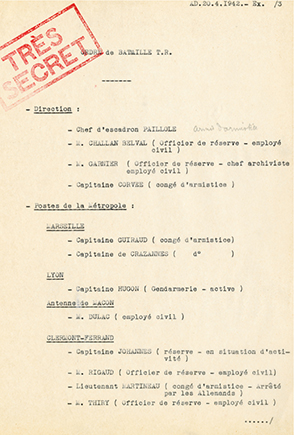
Ordre de bataille des Travaux ruraux, 20 avril 1942.
© SHD
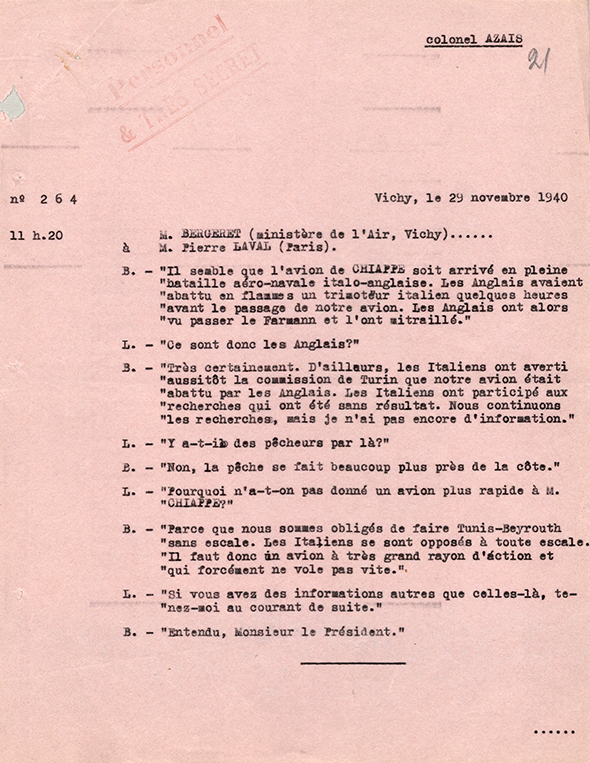
Compte rendu d'écoute téléphonique de Jean Bergeret, secrétaire d'État à l'aviation avec Pierre Laval, président du Conseil, 29 novembre 1940, p. 1.
© SHD
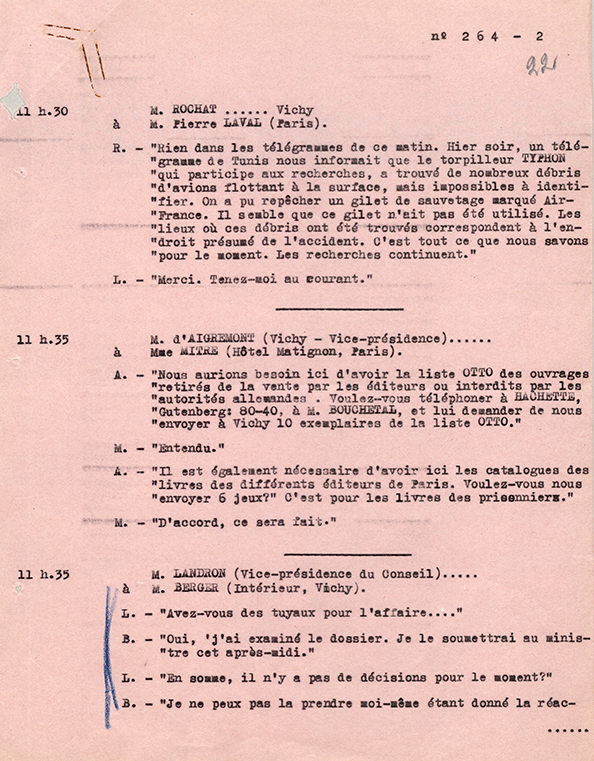
Compte rendu d'écoute téléphonique de Jean Bergeret, secrétaire d'État à l'aviation avec Pierre Laval, président du Conseil, 29 novembre 1940, p. 2.
© SHD
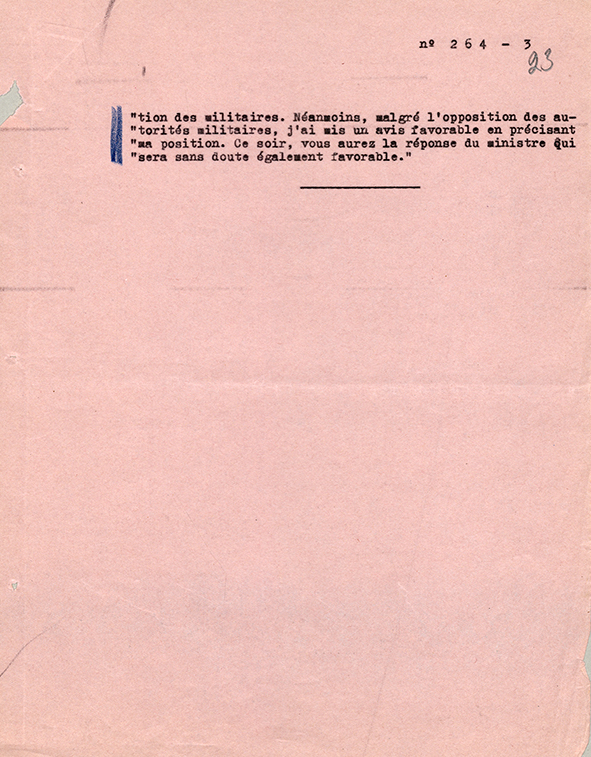
Compte rendu d'écoute téléphonique de Jean Bergeret, secrétaire d'État à l'aviation avec Pierre Laval, président du Conseil, 29 novembre 1940, p. 3.
© SHD
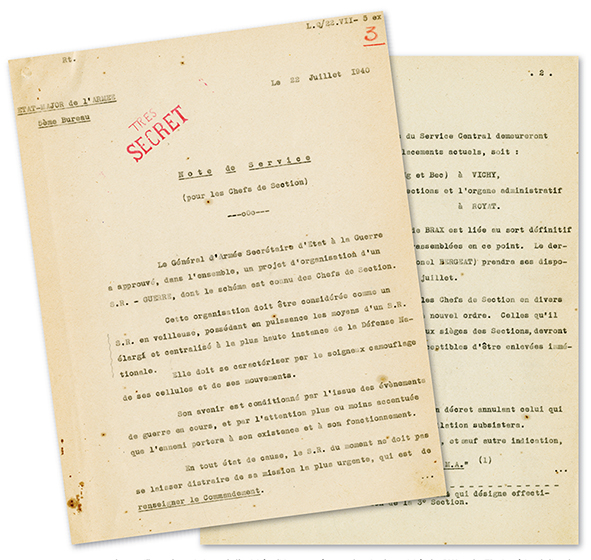
Note instituant le Bureau des menées antinationales, 22 juillet 1940.
© SHD
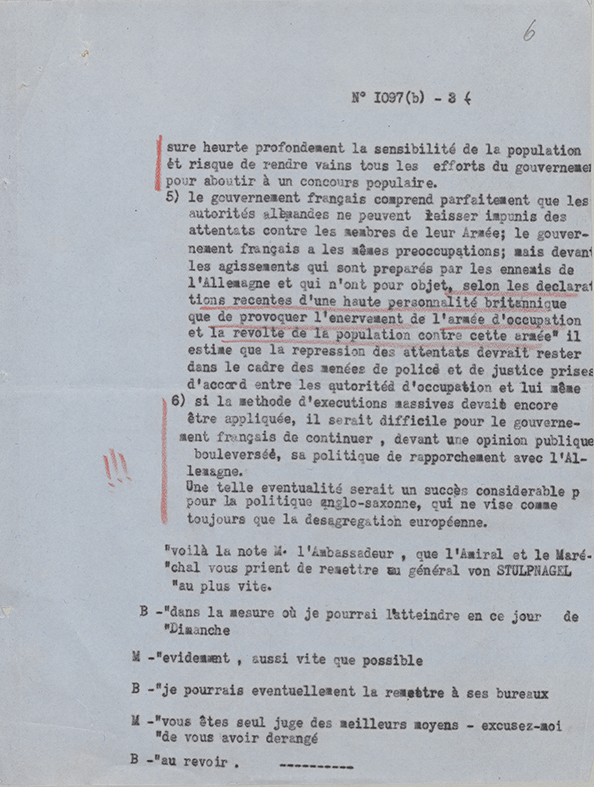
Compte rendu d'écoute téléphonique entre Fernand de Brinon, délégué général du gouvernement français dans les territoires occupés et Henry du Moulin de la Barthète, directeur du cabinet civil du Maréchal Pétain, 14 décembre 1941.
© SHD
